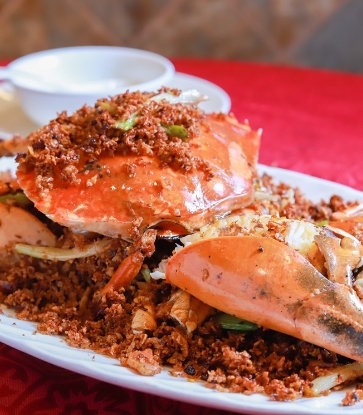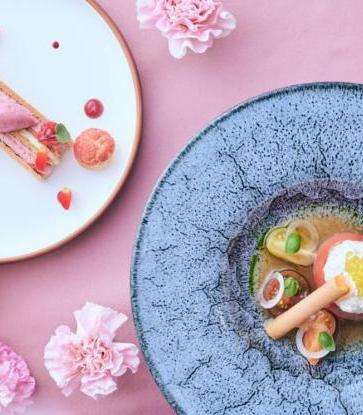Andō’s ‘Sin Lola’ caldoso rice
Agustin Balbi remembers very well when his grandmother cooked him caldoso rice for the first time.“I was having doubts about it because it looked like a soup with rice on it, not very great looking. Then, I tasted it -- Wow! It changed my little world at that moment. Nothing was the same for me since that day,” says Balbi, chef-founder of the innovative cuisine restaurant Andō.
Born in 1924 in Spain’s Mallorca, Balbi’s grandmother Maria Dolores Niell moved to Argentina when she was young with her family. It explains why she’d cook caldoso rice, a dish more common in Spain than in Argentina.
It has occupied a special place in Balbi’s heart since.

“I went to her house for lunch after school every day. She lived 10 blocks away from my school. In those 10 blocks, I’d think about what was going to be on the ‘menu’ that day. When I opened the elevator door and could smell the broth from the caldoso rice, my day was perfect -- nothing could go wrong from there.
“At that time on TV was a very famous Spanish chef called Karlos Arguiñano and we’d eat the caldoso rice together while watching the chef cook on TV.

“If magic even exists, I think it was very close to it.”

Magical moments like this inspired Balbi to pursue a cooking career. That’s also why caldoso rice has been a mainstay at Andō since it opened. Balbi named it after his late grandmother: Sin Lola.
“‘Sin’ means without in Spanish and ‘Lola’ was her name – short for Maria Dolores -- so it’s like I’m without her, but, at the same time, I’m with her through the dish I share with my guests,” Balbi explains.
Grandma Lola’s version of caldoso rice was rustic – with one broth and mostly chicken.
Balbi’s version uses ingredients that are different from his grandmother’s. He uses four different broths to develop a deep umami taste; Yumepirika rice from Hokkaido for its unique texture; and a splash of Sherry-casked sake at the end.
Clarence’s La Croûte de la Grand-mère
There are countless precious moments when Olivier Elzer’s mother influenced his cooking life.The first-dreaded-then-loved early market visits with his mother since he was a five-year-old.
The time when he sneaked out of bed to smell the beef stock cooking in the kitchen.
Or when his mother disapproved of his choice of becoming a chef at 14 but gave him a great piece of advice -- to work at MICHELIN-starred restaurants to learn from the best.
But one of his favourite memories was the story of the dish in Clarence’s first anniversary menu: La Croûte de la Grand-mère, translated as the grandmother’s crust.

“It's a funny story,” Elzer says.
When he was young, there was a bread-selling truck that went around the village every day, except for Sunday. So when Sunday night comes, the leftover bread would have become stale.
“One Sunday afternoon, I took candies from my mother’s room secretly which she, of course, didn't let me. So when she broke an old piece of dry baguette that night and put it on my dish, I thought she found out about the candies and she was punishing me by giving me a very dry piece of bread as dinner.

It became one of his most treasured food memories so he recreated the day in this dish. Clarence’s version is a morel mushroom and yellow wine soup sprinkled with liquorice powder – a nod to the candy incident on that day, poured over dried bread.
On this Mother’s Day, Elzer has a newfound feeling for his mother after he had invited her to Hong Kong and cooked with her in a four-hand dinner in March.
“You always think of your parents as if they were still 20 years old. When we cooked in the kitchen together, I was so excited and I was like, ‘Let's keep going.’ Then I started to see her sweating and she needed to take a break. She is 66 now. Those little things made me realize you need to take care of your parents and spend more time with them,” says Elzer.
Estro’s Mussels Gemmina
Antimo Maria Merone admits he’s always been a glutton. As a kid, he would curiously follow his grandmothers in the kitchens when they were cooking.
“Both my grandmothers had a very deep influence on my culinary background, and it was from them that I learnt my first steps in the kitchen,” says chef Merone of the Italian restaurant Estro.
One of his dearest dishes comes from his father’s mother.
“My grandmother Gelsomina (Gemmina in our dialect) used to cook this dish during winter time when mussels are abundant and the quality is better,” says Merone.
She was a farmer from a beautiful volcanic ancient Roman town called Baia, in Bacoli, where mussel farming is famous.
Grandma Gemmina makes the dish by opening the raw mussels and filling them with a mix of bread, egg, sausage or salami, parsley and garlic. The mussels would then be tightened up with a cotton string before being boiled in a tomato sauce.
“This will allow the mussels to firm up around the stuffing, while the mussel juice will be released into the sauce, giving flavour to the tomato -- a perfect sauce for what in Italian will call ‘Scarpetta,’” the Naples native explains.
The dish lives on Estro’s menu as Mussels Gemmina.

“It’s a dish extremely connected to my roots, that very well explains the concept of our culinary approach.”

Merone took the concept behind the dish but refined the dish in a few ways.
“As my grandmother used to do, we stuff the mussels from raw, with a farce (or stuffing) made of bread, Italian tiger prawns, parsley and egg white. We then steam them at a controlled temperature to keep the perfect moisture and texture. The mussels are then wrapped with ‘lardo’ and served with a sauce made of mussel juice, parsley extraction and garlic.
Agora’s Bacalao al Pil pil
Growing up, Antonio Oviedo’s playground was his mother's kitchen where he helped her cook and eat the dishes she created.“My mother passed to me a lot of wisdom from my grandfather, Antonio, about farming and rural traditions, like food preservation, olive oil-making, winemaking and foraging,” says chef Oviedo of Agora.
Raised in Extremadura -- the area in the south of Spain famous for its Iberico pork -- and learnt to cook northern Spanish cuisine when she is older, Oviedo’s mother and her diverse recipes become an enormous inspiration for the chef.
“It created the spark for me to become a chef,” says Oviedo.
The knowledge about Spanish traditional gastronomy from his mother has helped him create Agora.
“She still helps me every time I need to develop a dish that is part of my childhood memories,” says Oviedo.
One such dish is the Bacalao al Pil pil.


“Bacalao con pimientos (cod with peppers) is a traditional dish from Burgos, where my father comes from, a northern region of Spain that is influenced by the Basque and La Rioja cuisine,” Oviedo explains.
The recipe has been passed down and refined through generations.
His mother’s version pairs Bacalao con pimientos with Pil pil sauce, a northern Spanish delicacy.
Oviedo’s mother cooks the dish in a terracotta pot, the traditional way.
She starts by cooking olive oil and sliced garlic, before adding chillies, dry choricero peppers, as well as hydrated and preserved roasted peppers to the pot. Then, she adds the salted cod – which has been soaked overnight – to the pot and simmer it in low heat to preserve the flaky texture and collagen of the fish.
The collagen will then be whisked with the fragrant olive oil, creating the Pil pil sauce.
Once Oviedo finds a premium Bacalao from Spain available in Hong Kong, he decides to recreate the prized family recipe of Bacalao al Pil pil at Agora.

“When I showed it to her she was so impressed to see the final result and so happy to be involved in the creating process since I was asking her to explain to me step by step her recipe.”

“The flourishing flavours and essence of the dish are the same. At Agora, I’m using the same ingredients but we do a minimalistic approach to this traditional delicacy,” says Oviedo.
Agora’s the intense Pil pil sauce comprises a court-bouillon that is made with the skins and the bones of the cod. Choricero peppers are added to enhance the flavour before being emulsified with garlic olive oil. A fine mousseline with smoked piquillo peppers and roasted garlic is added at last.
READ MORE: 6 New Establishments Awarded a Bib Gourmand in the MICHELIN Guide Hong Kong & Macau 2023
Heimat’s Rhabarber Grütze
Peter Find, chef-founder of Heimat -- which means home in German -- can’t hide his pride in his mother’s cooking and family recipes.“My mother was always baking. She’d be the one that everyone in our village would ask to make cakes for celebrations and milestones. From an early age, I started helping her make things like crumbles – and especially when it came to licking the bowls.
“The centre of our home life was in the kitchen. It was where most of the conversations happened, where I did homework, and where I was, of course, first attracted to cooking and understanding that food as an expression of love,” Find remembers.
Much of the menu of Heimat -- from Hühner Schnitzel (chicken schnitzel) to Schlacht Platte (Butcher’s platter) to its spaetzle dish -- is inspired by his mother’s cooking he grew up with.



For the Mother’s Day menu at Heimat this year, Find will serve one of the most beloved desserts from his mother: Rhabarber Grütze, a homemade rhubarb compote with a hazelnut crumble and organic vanilla ice cream.
“Fruit compotes are a big thing across Germany. We have a lot of wild rhubarb growing in my village, including a massive bush in my mother's yard. Every year we’d pick and peel the rhubarb and make it into compote that we would then use to make cakes and crumbles.
“My mother's rhubarb cake was infamous in our village,” Find adds.
Heimat’s rhubarb dessert won’t be very different from his mother’s rhubarb dessert, except for the overbaked crumbles and the added hazelnuts.
“On a trip back to visit a few years ago, I even showed my sons and took pictures of them with the bush because it is so special to me,” says Find.
This article is written by Maggie Hiufu Wong for MICHELIN Guide Hong Kong and Macau.
Hero image provided by Andō restaurant.














